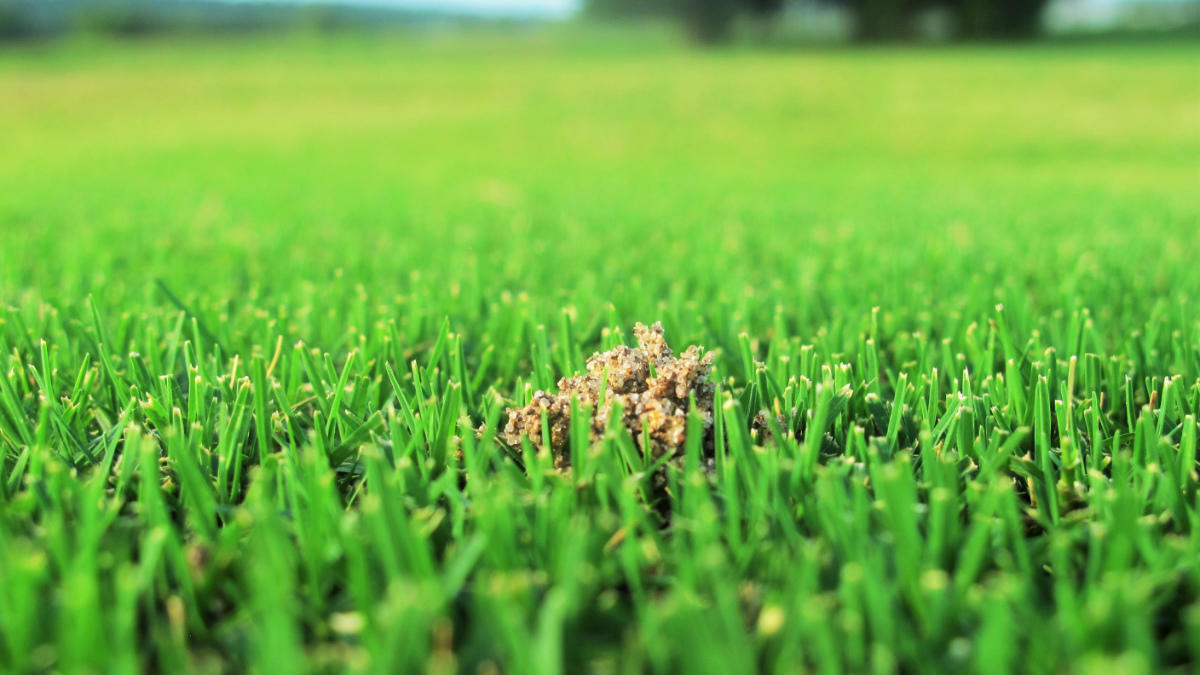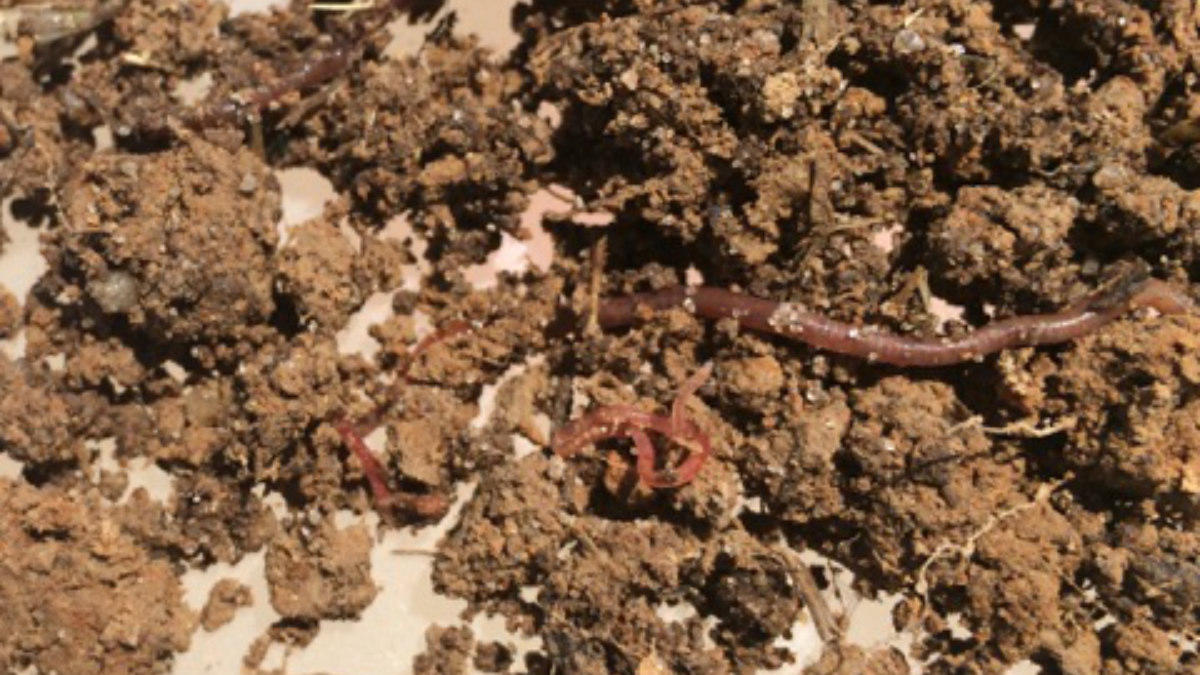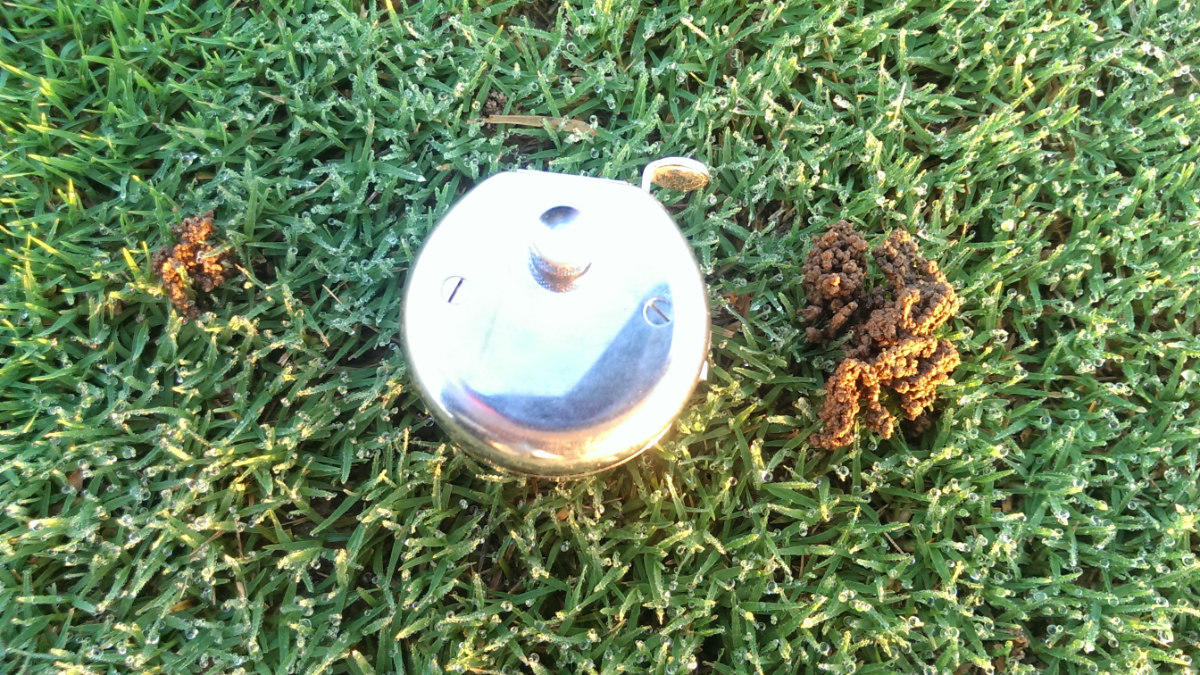- Homepage
- News and Features
- What are worm casts and what can be done about them?
What are worm casts and what can be done about them?

Earthworms are generally considered to be beneficial organisms as their burrowing activity enhances water and air movement through the soil and moves organic matter into the profile.
Earthworm faeces are high in nutrients and can help ‘glue’ soil particles together to help improve soil structure. Earthworms can also stimulate microbial activity, which helps break down thatch.
In golf turf, though, excessive production of earthworm faecal matter, commonly called ‘casts’, has many negative effects when casts are deposited above the turf canopy. Surface casting can result in a muddy and uneven playing surface and can interfere with quality and height of cut if casts build up on mower units. Earthworm activity can also lead to pest invasion. Casts deposited on the turf surface can retain moisture and lead to turfgrass disease. Earthworms can also mine weed seed from the profile; when the seeds are deposited above the turf among nutrient‑rich cast material, weeds can germinate and become problematic. Additionally, cast material that is smeared across a turfgrass leaf may prevent photosynthesis, resulting in weak,
thin turf.
Earthworms vary in their environmental tolerances. Earthworms require moist soil to maintain their external mucus membrane, which helps prevent desiccation and facilitate air diffusion for breathing. Some earthworms, such as Eisenia fetida, also secrete toxic mucous that helps ward off predators. Most earthworms prefer soil pH between 5.0 and 7.0 and soil temperatures around 10‑16 °C, though pH and temperature tolerances vary by species.
Earthworms are usually rare in sandy soils, due to the potential for dry conditions, diluted organic matter, and the abrasiveness of the sand particles. Nevertheless, some species (such as Amynthas hupeiensis) are commonly found casting on sand‑based greens and tees throughout the world. Earthworms are also usually less common in heavy clay soils where saturated conditions may reduce oxygen gas concentrations and restrict the air diffusion process necessary for earthworms to breathe. Additionally, if soils become compacted, earthworms that would normally cast within the soil profile may cast at the surface, since pockets for cast deposition may not be available within the compacted soil profile. This may occur on golf turf in native‑soil areas where foot traffic is concentrated or where heavy machinery is routinely used.
Not all worms are created equal
Earthworms can be broadly classified based on their burrowing and feeding habits. Anecic earthworms create permanent vertical burrows which open to the soil surface; these burrows can extend several metres into the soil profile. Anecic earthworms pull turf clippings into their burrows to feed, then return to the turf surface to cast. Endogeic earthworms form non‑permanent horizontal burrows within the soil profile and consume the surrounding soil and organic matter. Epigeic earthworms live at the soil surface and feed on the surface‑level litter layer. In irrigated golf turf, nuisance surface‑casting earthworms are usually endogeic or anecic species.
Earthworm Reproduction
Earthworms are hermaphroditic, meaning, potentially, that instead of roughly half the population producing offspring each reproductive cycle, every adult earthworm within the turf system may produce offspring. Earthworms can deposit multiple eggs within each cocoon, and most earthworms can reproduce multiple times throughout the season, if conditions are favourable. Some species can even reproduce without a mate, a process called ‘parthenogenesis’. Therefore, transfer of a single cocoon or a few individuals into the turf system can result in rapid population growth. Reproduction rates vary depending on species and environmental conditions.
Cocoons are selectively permeable, resistant to desiccation and can withstand high and low temperature extremes. Earthworm cocoons can delay hatching for several years, leading to the build‑up of a ‘cocoon bank’ within the soil profile; when conditions are favourable, they will hatch. Similarly, some earthworms – anecic species, in particular – can move to the bottom of their several‑metres‑deep burrows and enter a hibernation state to avoid unfavourable conditions like temperature or moisture extremes. Once tolerable » conditions return, they resume activity near the soil surface.
Earthworms or cocoons may be introduced when compost or mulch are brought on site for landscaping areas, garden beds, or the course itself. Sod can also be a potential source of both earthworms and cocoons – many earthworms are active within and deposit cocoons within the rootzone, which gets transferred with the sod. Topdressing or construction sand may also be a source of cocoons if the sand is sourced from river dredge material; this is especially problematic in areas where anglers dump unused live bait in or near the riverbank.
Adult earthworms are discernible by the characteristic swollen band toward the head‑end of the earthworm. This band, called a ‘clitellum’ is a sign of sexual maturity and is not present in juveniles. Juvenile worms are focused on building biomass and as a result, they are often more voracious eaters – and casters – than adults, who are more focused on reproduction. Most turf systems will have a mixture of several species. One species may be actively casting for a few weeks in early spring, followed by a second peak of activity by a second species, which may overlap with that of a third species, and so on.

Casting Control Options
The revocation of carbendazim in 2017 means there are no legal methods of controlling earthworms with pesticides. Because of this, many turf managers have turned to cultural management options.
Acidifying fertilisers have been used in an effort to reduce soil pH to levels at which earthworms are unable to inhabit the soil. Success has varied, likely due to differences in pH tolerance between earthworm species. Additionally, the process of pH modification using acidifying fertilisers can take a very long time and requires a large amount of product. Application of acidifying fertilisers at high rates can be phytotoxic to turf and can be environmentally hazardous if excess nutrients runoff into surrounding water bodies or leach out of the system. Excessive fertilisation can lead to excess turf growth and can promote thatch accumulation, especially if earthworms move out of the area and are no longer stimulating microbial activity or helping to break down organic material. Generally, most earthworms are abundant in soils with a pH between 5.0 and 7.0 and most turfgrasses grow best between 6.0 and 7.0, so altering soil pH enough to move earthworms out of the system is usually not compatible with maintaining healthy turf.
Several studies have also looked at removal of organic matter to eliminate the earthworms’ food source and drive earthworms off the playing surfaces and into surrounding areas. This method, too, has seen varied success. Vertical mowing, thatch removal, or bagging clippings typically does not lead to reduction of casting. In fact, removing organic matter may have the opposite effect as earthworms are then forced to ingest a greater volume of soil to obtain the necessary amount of nutrients. More ingestion equals more egestion and more egestion equals more casts.
Sand topdressing has been a popular option for mitigating casting on short‑cut in‑play turf. The theory is that by diluting the organic matter, reducing the moisture content and adding abrasive particles to the soil profile, the soil will become less hospitable for the earthworms and they might move to surrounding out‑of‑play areas. Topdressing has had varied effects on earthworm casting. More angular sand will likely be more irritating to the earthworms’ soft bodies, while rounded »
or sub‑rounded sands may not be abrasive enough. Rootzone may also be a factor – the topdressing rate that reduces casting over a native soil may not have the same effect on a sand‑capped profile. Regardless of whether casts are reduced, topdressing has the potential benefit of increasing the sandiness of casts. Sandy casts can then be more easily brushed, mown, blown, or dragged into the turf canopy compared to muddy casts.

Conclusions
The best first step is to determine how concentrated or widespread the casting issue is. If there are narrow bands of heavy casting surrounded by cast‑free areas, it is a good idea to test the cast‑heavy and cast‑free areas. There may be a low‑lying section where the soil remains moister and serves as an earthworm oasis. There may be some compaction issues. The organic matter may be greater than the cast‑free zones (or vice‑versa). Treating these small zones will require less effort and cost than treating the entire course. Likewise, certain tactics may not work on all areas. A targeted approach may be necessary – for example, using varied topdressing rates across different rootzones rather than a blanket topdressing rate for the entire course.
Because earthworms are considered beneficial organisms, it is important to retain them in the system; however, earthworm casting can cause numerous problems for turfgrass health and management. Different earthworm species and different life stages likely respond differently to cast‑management practices. An integrated approach combining a succession of targeted casting control tactics throughout periods of heavy activity will likely be most advantageous for reducing issues. Alternatively, shifting the mindset from managing the earthworms to managing the casts – increasing the sandiness and thus, the ease of dispersion back into the turf canopy – may allow turf managers to preserve the benefits of below‑ground earthworm activity while reducing the severity of issues caused by above‑ground casting. Additionally, educating golfers about the benefits of having earthworms in the turf system, the issues caused by casting and the restrictions on earthworm management options may help to mitigate negative golfer perception.
This article was first featured in the April 2021 edition of Greenkeeper International available for BIGGA members to read online here.
Author

Paige Boyle
Paige Boyle is a Presidential Doctoral Research Fellow at Utah State University. She earned a bachelors in Environmental, Soil, and Water Sciences and masters in horticulture from the University of Arkansas. As part of her doctoral dissertation research at Utah State, she is studying ecosystem services of low-input systems on golf courses in the western US. Her research background includes stream restoration design, in-vessel compost processing, and earthworm management on golf course turf
